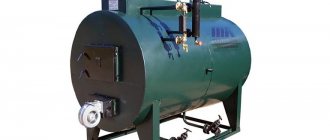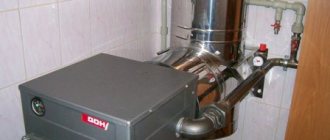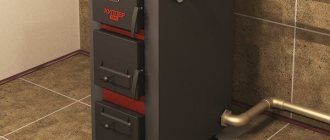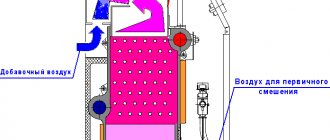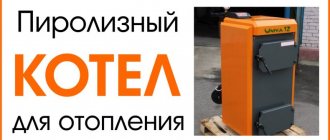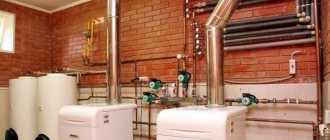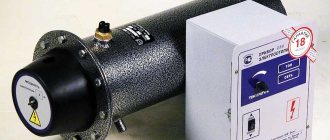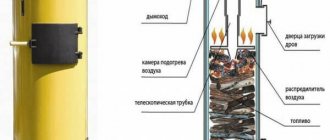← previous articleFeatures of constructing boiler houses on the roof A boiler house on the roof is a fairly effective solution in the field of heat supply to residential, domestic, administrative buildings and industries. Essentially, a rooftop boiler room is a container or a stationary room placed directly on the roof...next article →Coal boiler roomWhat do most people associate with a “coal boiler room”? Probably with labor-intensive work, endless putting coal, soot and dirt into the firebox. Fortunately, such times are long gone, and today a coal boiler house is an automated...
Author: Alyansteplo
Date: 12/12/2015
- 1. Operating principle of oil boiler houses
- 2. Advantages and disadvantages of oil boiler houses
Boiler houses using fuel oil are not in such great demand as, for example, gas or diesel models, but they are in demand among Russians. In fact, they are completely autonomous boiler systems running on inexpensive fuel oil of the M100 or F40 brands. Among their advantages - in addition to autonomy and the ability to use them in areas cut off from centralized gas supply - is also a fairly high efficiency.
Oil-fired boilers can also be used in combined installations with backup power supplies. In such designs, the main power comes from gas, and the oil boiler turns on if the gas supply fails, thus allowing uninterrupted heat or water supply. Such boiler houses are called gas-oil boilers.
Features of heating boilers operating on fuel oil
Such heat generators are similar in degree of automation to gas ones, but fuel for them is as common as for coal or wood ones. The combination of these qualities makes this equipment in demand in areas where centralized energy supply is represented only by the electrical network.
Oil heaters are used mainly in industrial boiler houses. Models for private homes are still much less common than diesel models.
Features of the units:
- Energy dependence.
- Electronic automation.
- Turbocharged combustion chamber without communication with the room. Air is sucked into the firebox by a fan from the street through the internal channel of the coaxial chimney.
- Forced exhaust removal, which allows the pipe to be positioned horizontally.
- Work only with closed heating systems equipped with circulation pumps.
Areas of use
Fuel oil heating equipment is in demand far from large populated areas. Oil as a fuel is widely used in the development of oil fields, pumping stations and in other cases when it is present directly at the point of use. Heating oil workers' settlements with crude oil minimizes the utility costs of the oil production enterprise. Steam plants are used in various fields of economy and production. Boilers with operating pressures up to 0.7 MPa are in demand at construction sites, agriculture and the food industry. The process of their operation is safe, and approvals from Gosgortekhnadzor are not required.
Design specifications
The parameters of the liquid fuel boiler are:
- heat performance;
- volume of the boiler tank (heat exchanger);
- maximum pressure of the working medium;
- type of fuel;
- electrical power consumption;
- efficiency;
- dimensions and weight.
The efficiency of an oil-fuel boiler is 75–85%.
The efficiency of such installations is in the range of 75–85%.
Functions
The unit heats the coolant circulating in the liquid heating system. 2-circuit models additionally provide hot water supply.
Thanks to the electronics, the following functions are available:
- programming;
- control from a smartphone;
- work with weather-dependent automation.
Operating principle
Fuel is supplied under pressure into the nozzle and is sprayed out of it to form small particles. They quickly evaporate, mix with air and ignite.
The heat from the fire and the hot exhaust heat the water in the boiler tank. Thanks to the pressure created by the circulation pump, it moves along the circuit and imparts the resulting energy to the air in the rooms through radiators.
The fuel in the boiler is atomized into small particles.
The operation of the boiler consists of alternating 2 modes:
- heating;
- expectations.
The first one ends at the moment when the sensor detects an excess of the coolant temperature and sends the controller a command to stop supplying fuel. The flame dies out and the device goes into standby mode.
After the coolant has cooled by 5°C, a start command is received and the supply of fuel oil to the nozzle is resumed.
At the same time, the electronic ignition device generates a spark, causing the fuel to ignite.
Device
The main component of the heat generator is the burner. It turns the fuel oil flow into a fuel-air mixture, which then burns here.
The burner is equipped with a normally closed solenoid valve. It is held in working position by the field created by the coil when current flows through it.
The power supply stops and the valve closes in the following cases:
- the flame has gone out and cannot be rekindled;
- there is no draft in the chimney;
- The coolant has heated above the set temperature.
Construction of a fuel oil boiler.
The heat exchanger is a structure of tubes and plates. This device ensures maximum absorption of the generated energy.
An integral part of the boiler room is the fuel supply system.
It includes the following elements:
- Insulated fuel oil storage tank.
- Pump.
- Coarse and fine filters.
- Heating unit.
- Fuel supply line.
A container for storing diesel fuel is often buried in the ground, where it does not take up useful space and is protected from the cold.
Operating principle of PM
According to the principle of operation, PMs are classified as recuperative shell-and-tube heat exchangers of the “pipe-in-pipe” type, which are a housing called a casing, inside of which several dozen tubes of smaller diameter are placed, assembled into a tube bundle. The steam coolant moves in the inter-tube space, the fuel oil moves in the heat exchange tubes. Heat exchange between steam and fuel oil occurs through the heat-conducting walls of the tubes due to the temperature difference.
In Fig. Below is a drawing of a typical fuel oil heater:
- pos. A – pipe for fuel oil inlet;
- pos. B – pipe for fuel oil outlet;
- pos. B – pipe for heating steam;
- pos. G – condensate outlet pipe;
- pos. D – fitting for air suction;
- pos. E – air vent;
- pos. F – drain plug.
Through pipe A, fuel oil is supplied to the PM pipe system. In the process of moving inside the heat exchange tubes, the fuel oil is heated to a given temperature and leaves the heater through pipe B. Live steam for heating the fuel oil is supplied through pipe B into the interpipe space in the casing, transfers its thermal energy to the fuel oil and cools, condensing on the outer walls of the pipes and the inner surface of the casing. The resulting condensate is removed from the PM through pipe G. To increase the efficiency of heat exchange, the fuel oil mass makes 12 strokes in the heat exchange tubes before it is heated to the required temperature. The air accumulated in the volume of the casing is discharged through fitting D.
Performance characteristics of fuel oil as a fuel
This type of fuel is obtained in 2 ways:
- direct distillation of oil;
- cracking - heat treatment of intermediate fractions.
Fuel oil is obtained by direct distillation of oil or heat treatment.
The product is a mixture of components:
- hydrocarbons with a molecular weight from 400 to 1000 (99%);
- petroleum resins;
- asphaltenes;
- carbenes;
- carboids;
- organic compounds, including bismuth, nickel, iron and other metals, as well as sulfur.
There are several brands of heating oil.
They are divided into 3 types:
- lungs – F5 and F12;
- medium – M40 and M40B;
- heavy - M100 and M100B.
The first type is used mainly on ship installations.
The operational characteristics of fuel oil include:
- Specific heat of combustion – 39.4–40.7 MJ/kg.
- Viscosity – 8–80 mm²/s.
- Pour point – -5…+40°С.
- Density – 0.89–1 g/cc.
- Sulfur content – 0.5–3.5%.
- Factory retail price – 20 thousand rubles/t, wholesale – 11.5.
The specific heat of combustion of fuel oil is 39.4–40.7 MJ/kg.
The cost of kWh obtained by burning fuel oil is 1.35–1.80 rubles.
For other types of fuel this figure is equal, rub.:
- main gas – 0.5;
- LNG – 2.5;
- firewood – 0.9;
- pellets – 1.33;
- coal – 1.6;
- diesel fuel – 2.8;
- electricity - 3.5.
Due to its high viscosity and pour point, fuel oil must be heated before feeding into the burner to:
- +80…+120°С – if it is under pressure in tanks or coils;
- 10°C below the flash point when kept in open containers (for different brands it is +90...+150°C).
When fuel is burned, sulfur dioxide is formed. This substance is harmful to humans - it causes a sore throat, inflammation or burn of the mucous membranes.
Preference should be given to products with minimal sulfur concentration.
Fuel oil may contain liquid. It reduces the heat of combustion and causes corrosion of metal surfaces. The water is separated by settling, which takes from 4 to 8 days.
Instructions for making a simple potbelly stove with your own hands
Sometimes situations arise when it is necessary to heat a small space (garage, workshop or warehouse) as efficiently and quickly as possible without significant material costs. An excellent solution to the problem would be a compact potbelly stove made by yourself, the creation of which requires ingenuity, desire, tools and metal.
- 1 Introductory video on the operation of the furnace
- 2 Rectangular stove with reflector
- 3 Simple potbelly stove from a can 3.1 Video - another option for making a stove
A simple potbelly stove can be built from materials that are at hand. You can use a regular can or a thick-walled barrel. Many years of practice have shown that very thick metal (over 8 mm) is too difficult to heat. Thus, the efficiency decreases and most of the heat is not used for heating.
If the metal is too thin, under the influence of high temperatures it will begin to deform and quickly lose its original shape. The best option is walls of about 3-4 mm.
If the metal is too thin, under the influence of high temperatures it will begin to deform and quickly lose its original shape. The best option is walls of about 3-4 mm.
Schemes of potbelly stoves
The main advantage of a rectangular stove
, unlike oval products made from pipes or gas cylinders, lies in a larger heated surface area, so its efficiency will be much greater. The optimal size for a potbelly stove is 800x450x450 mm. A stove of this size will not take up much space and will easily fit even in a small room.
Types of burners for oil boilers
The main part of the heater is:
- hinged (removable);
- built-in
The main part of the heater can be removable.
In the first case, it is possible to replace it, for example, with a gas one.
There are these types of burners:
- Mono-fuel. Designed only for 1 brand of fuel oil.
- Multi-fuel. Can be reconfigured for any type of liquid fuel - different brands of fuel oil, diesel fuel, used machine oil.
- Combined. They work with liquid fuel and gas, incl. in the form of a mixture.
The first type, in comparison with the other 2, has the following advantages:
- low cost;
- simple design;
- unpretentiousness in maintenance.
Combination burners are used mainly in industrial installations.
They are distinguished by:
- complex design of nozzles;
- the need for high-precision dosage of mixed components due to their different combustion rates.
According to the method of spraying fuel oil and forming a fuel-air mixture, burners for household boilers are of the pneumomechanical type. They are equipped with chambers for preheating fuel to +80...+120°C.
Combination burners are used in industrial boilers.
Those are:
- rotational;
- steam-mechanical.
Heating leads to a decrease in fuel viscosity.
Depending on the ability to regulate power, burners are divided into:
- 1-stage. Operate at constant power. The boiler performance is regulated by periodically turning off the burner.
- 2-stage. They operate in 2 modes - 50% and 100% of rated power. They allow the boiler to smoothly reach maximum performance and turn off less frequently, thereby extending the service life of the device.
- Modulated. Smoothly change power in the range from 10% to 100%. The boiler operates continuously, which eliminates temperature fluctuations and thereby extends its service life to the maximum.
1-stage burners are the cheapest, modulating burners are the most expensive.
The operating principle of the liquid fuel installation and its design
The principle of operation of the boiler is in many ways similar to the operation of a gas floor-standing appliance. The main distinguishing feature is the difference in their designs.
Homemade liquid fuel products have a fan burner for exhaust. Its function is to atomize fuel under high pressure and then feed it into the combustion chamber. The atomization process involves a nozzle that distributes the fuel into small droplets. The raw material itself is transformed into a fog-like form and mixed with the air flow forced by the fan.
The mixture of air and fuel entering the burner leads to the ignition process.
The main characteristic of the effective operation of equipment is its power. In order to understand what power you need a boiler to create a comfortable microclimate, you should carry out a series of thermal calculations.
Factors that are taken into account when calculating the power of the installation:
- area of the heated room;
- number of doors and windows in the room;
- walls and their thickness;
- floor thickness;
- presence of thermal insulation.
In addition, the number of people living also matters in calculating the required power. It is better to entrust such calculations to professionals from the company where you ordered the equipment.
At home, you can only determine the approximate value of the parameter. On average, for a house whose ceiling height does not exceed 3 m, you should purchase a device in accordance with 1 kW of power for every 10 m 2 of area.
Gas burner operating diagram
Criteria for choosing a unit for a private home
The heater is selected according to the following parameters:
- rated power;
- efficiency;
- maximum pressure in the boiler tank;
- heat exchanger material.
The heater is selected according to its rated power and efficiency.
The first one is the main one. The rated power should compensate for the heat loss of the house during the coldest period.
This value is determined by a complex calculation that takes into account a number of factors:
- temperature difference between inside and outside;
- the thickness of the enclosing structures and the thermal conductivity of the materials from which they are made;
- area and type of glazing;
- air exchange rate.
For a rough estimate, you can use a simplified formula:
W=0.1*S, where
- W – rated power, kW;
- S – heated area, sq.m.
This ratio is valid for houses with the following characteristics:
- ceiling height – up to 3 m;
- windows - with double glazed windows;
- thermal resistance of enclosing structures corresponding to the recommended SNiP “Building Climatology” for the given region.
Residents of northern latitudes add 20%. If the house is additionally insulated, the calculation result is multiplied by a factor of 0.8.
Efficiency means the efficiency of fuel combustion. The higher this indicator, the lower heating costs.
Heat exchangers for oil-fired boilers are made of steel.
The maximum permissible pressure of the working medium in the boiler tank must exceed the value developed by the circulation pump or created by the water column in multi-story buildings.
Heat exchangers are made from the following materials:
- cast iron;
- become.
The first option is more durable, which is explained by the absence of weak points in the design and resistance to corrosion.
Disadvantages include:
- high price;
- heavy weight (only floor installation is allowed);
- impossibility of repair.
Steel heat exchangers last less and, due to the presence of welded seams, are inferior to cast iron in reliability.
But then they:
- cheap;
- light weight (wall installation possible);
- repairable.
When choosing a boiler, other criteria are also taken into account.
Heat generation method
There are 2 types of heaters:
- traditional;
- condensation
The condensing boiler absorbs the energy of water vapor.
The latter absorb additional energy contained in water vapor. It condenses in a special chamber. The efficiency of such installations reaches 95%, while for traditional ones this figure is 75–85%.
But condensing heaters can only work with low-temperature systems - “warm floors” and heating panels.
Single or double circuit
The choice depends on the purpose of the device. If it is additionally assigned the function of supplying hot water, a 2-circuit model is needed. The required power is 20% more than calculated based on heat loss.
According to users, buying a 2-circuit boiler with a capacity of less than 20 kW does not make sense. Hot water flows in a thin stream, it is only enough to wash your hands. In this case, it is better to purchase a model with a built-in boiler.
Automation
The operation of the boiler is controlled electronically.
Minimum features:
- maintaining the coolant temperature within the limits set by the user;
- power supply is interrupted when the draft is disrupted and the flame goes out.
Automation allows for remote control.
Automation in the most expensive boilers provides the following capabilities:
- Programming. The user creates a schedule of changes in the temperature of the coolant or air in the room for each day of the week or month.
- Remote control. The heater is started, turned off or programmed via SMS messages.
- Weather dependent control. Using a remote sensor, the boiler analyzes the temperature outside and, depending on this, selects the optimal operating mode.
Type of coolant
The following types of working media are used in liquid heating systems:
- water;
- antifreeze.
The second type does not freeze in winter, which allows you to leave the house for a long time without emptying the circuit. But antifreeze has an aggressive effect on materials and has a lower heat capacity than water. Therefore, not all boilers can work with such liquid.
Complete set of fuel oil boiler room
Since these complexes are liquid fuel, the production of an oil boiler depends on various factors:
- Required power.
- Fuel oil stock quantities.
- Options for fuel delivery and storage.
High-quality construction of fuel oil boiler houses is based on accurate calculations and careful selection of appropriate equipment:
- Building.
- Boilers.
- Pump group.
- Expansion membrane tank.
- Fuel supply, unloading and storage system.
- Fuel purification filters.
- Chimney.
- Control system.
- Alarm and other components.
After weighing all the pros and cons, many customers choose fuel oil boiler houses, the price of which varies within reasonable limits. The cost of the system largely depends on the required power and size.
When creating a project for a boiler house using fuel oil, a diagram, drawing, technological map and other calculations are required. Employees are always ready to: correctly calculate the required amount of fuel, the total power of the installation, take into account the availability and need to order the appropriate components, calculate the total amount of investment, etc.
It is best to find out the cost and buy an oil boiler from a specialized company that has:
- Considerable experience in this field.
- All permits.
- Lots of good reviews from established clients.
Popular makes and models
Fuel oil boilers are produced by many domestic and foreign companies.
The following brands received the highest ratings from users:
- "KV Boiler". The Russian manufacturer offers installations for industrial boiler houses with a capacity of up to 3 MW. The smallest unit costs 1.2 million rubles and is designed for a heated area of 25 thousand square meters. m.
- Buderus. German company, a world leader in the production of heating equipment. It offers several liquid fuel models, among them the G125 SE-25 at 25 kW for 136 thousand rubles. and G125 SE-32 at 32 (kW) for 151 (thousand rubles)
- Protherm. A manufacturer from Slovakia has combined oil heaters into the “Bison” series. Their cost is 36–55 thousand rubles. The burner is not included in the price; it must be purchased separately.
- De Dietrich Thermique. The product range of this company from France includes the GT line of liquid fuel units. All are made of high-quality corrosion-resistant cast iron. Their cost is 70–90 thousand rubles, the burner must be purchased additionally (for 35–38 thousand rubles).
- Unical. The Italian brand actively cooperates with leaders in the production of burner devices - companies FBR (Italy) and SAACKE (Germany). Produces various diesel and fuel oil boilers, incl. Trypass 12/15 series with reduced emission of substances harmful to the environment. Minimum power – 64 kW, cost – from 200 to 360 thousand rubles.
"Kotel KV" is a Russian manufacturer of fuel oil boilers.
SAACKE burners operate efficiently even with dirty fuel and do not require frequent cleaning.
Description of the fuel oil boiler room
An oil boiler house is a well-organized heating installation equipped with high-quality equipment. The popularity of such complexes is explained, first of all, by the fairly low price of fuel.
The operating principle of an oil-fired boiler room is to use this type of fuel to heat the coolant to the required parameters. The proposed installations can be used as emergency or backup systems in the event of a failure in the operation of systems with the main type of fuel (for example, gas).
Fuel oil boiler houses (SPb) include fuel oil facilities. If this type of fuel is “spare”, then one tank is provided for its storage. If fuel oil is the main fuel, two containers are used. The amount of substance is designed for autonomous operation of the system for a certain time.
Oil-fired boiler installations (systems) operate on high-calorie fuel material. The most acceptable option for high-quality operation of the complex is the F 40 brand, but, as practice shows, the M 40, M 100 and M 200 brands are most often used.
Boiler houses using fuel oil in Russia (St. Petersburg) are offered by many companies. But it’s worth spending time and finding the most worthy one, since the correct design and competent assembly are the key to the future successful operation of the complex.
Operating rules for oil boilers
The following requirements apply to oil heaters:
- Appliances with a power of up to 60 kW are located inside the house, separating the furnace room from the others with a partition made of non-combustible material; more productive ones are located in a separate building. The boiler room must have windows with ventilation and supply and exhaust ventilation.
- Containers with fuel are located in another room, separated by a partition with a fire resistance of at least 50 minutes. The minimum distance to the unit is 5 m (for industrial boiler houses – 9).
- In the combustion chamber, containers with a volume of no more than 5 cubic meters are installed.
- In the event of a power outage, the heater and fuel supply system are connected to an uninterruptible power supply. The battery capacity must ensure autonomous operation for 12 hours.
- In places where the chimney passes through building structures with flammable materials, a fire-proof cut with heat-insulating padding is installed.
- No flammable substances are stored in the boiler room, incl. oily rags and petroleum products, except fuel for the unit.
- A gas sensor is installed in the room with the heat generator. It warns of high concentrations of vapors and, as a result, of the danger of explosion.
- The device is heated only with those types of fuel that are indicated in the passport. Failure to comply with this rule increases the harmful effects of exhaust on the environment.
- The burner nozzles are regularly cleaned of dirt, the combustion chamber and chimney are cleaned of soot. If this is not done, the soot may ignite, leading to a fire. A specialist is invited for service.
- At the beginning of each season, a test run of the device is performed. The meter determines fuel consumption per hour. If the indicator exceeds the passport data by more than 10%, the boiler is configured and adjusted.
Petroleum products other than fuel are not stored in the boiler room.
Which solid fuel is better?
Briquettes
Briquettes
is one of the types of solid fuel made by pressing materials such as shavings, bark, wood dust, straw, wood chips, husks and peat.
There are currently 3 types of briquettes sold on the market:
- RUF
- rectangular briquettes; - NESTRO
- in the form of cylinders with a through hole; - Pini&Kay
- faceted shape (4,6,8 sides).
RUF - rectangular briquettesNESTRO - cylinder-shaped briquettes with a through holePini&Kay - faceted briquettes (4, 6, 8 sides)
They are manufactured using modern European equipment and meet the requirements of technical safety regulations, for which they received their second name - Euro firewood.
Advantages of fuel briquettes:
- are made from environmentally friendly raw materials. When burned, they do not emit harmful substances;
- convenient to store. Thanks to their special shape and heat treatment, they are not exposed to fungi and can be stored outdoors for a long time;
- long and uniform combustion.
- high calorific value. 2 times higher than that of firewood;
- acceptable price;
- ash content level - 1-2%.
Pellets
Pellets
. They are made from the same raw materials as briquettes. However, the production process is slightly different. At the first stage, all materials are crushed to the state of pollen and then dried. After which a special mechanism forms small cylindrical granules from the resulting mass. Thanks to the compact size of the pellets, it has become possible to automate the process of heating a house using solid fuel by supplying a certain amount of pellets from the storage bin to the boiler.
There are several types of pellets:
- from hard and soft wood;
- peat;
- from sunflower husk;
- straw
Wooden pelletsPeat pelletsSunflower husk pelletsStraw pellets
This type of solid fuel is most suitable for use in individual heating systems.
Fuel advantages:
- made from environmentally friendly raw materials;
- can be stored outdoors - they do not swell from moisture and are not protected from the formation of fungus;
- ensure long and uniform combustion;
- due to its small size, it is suitable for automated heating systems;
- wide range of applications - stoves, boilers, fireplaces.
Firewood
Firewood
. This is the most accessible and cheapest type of fuel. And in some areas, firewood can be obtained for free.
The main disadvantage of this option is the need to maintain a certain level of moisture in the logs. Only if this condition is met will the firewood burn well. For high-quality heating, it is necessary to use tree species that burn for a long time. The best options are birch, oak, ash, etc. Coniferous trees are not entirely suitable as solid fuel. When burned, they release a large amount of tar and also have a low specific heat of combustion, so they require frequent loading.
Firewood has few advantages, but they still exist:
- during the combustion process, a minimum amount of caustic substances is released, which means no harm to the environment;
- due to the low level of sulfur content, the corrosive effect is significantly reduced;
- after burning, a small amount of ash is formed - approximately 2-3% of the mass.
Coal
Coal
. This solid fuel is also available in several types: anthracite, stone and brown. Coal is most often used for heating systems.
Main advantages:
- high calorific value;
- ease of storage;
- in many cities, prices for other types of solid fuel are significantly higher than for coal;
- Compared to other fuels, the boiler needs to be filled 2-3 times less often.
But coal also has a considerable number of disadvantages. During combustion, about 40% of the initial mass of ash remains. This means that it will be necessary to allocate a special place for its storage and consider the disposal process. The smoke released during combustion is very corrosive. This is explained by the large amount of sulfur contained in coal. Once in the atmosphere, it is converted into sulfuric acid. Therefore, smog and an unpleasant burning smell may appear indoors and outdoors. However, coal manufacturers and suppliers are trying to combat this disadvantage by creating new boiler models that prevent such substances from entering the air.
Advantages and disadvantages
The strengths of oil-fired boilers are:
- High degree of automation.
- Work with minimal human intervention.
- Regulation of heat transfer over a wide range.
- Widespread availability of fuel.
- Versatility. Most models can be easily and inexpensively converted to use gas.
- Easy installation. There is no need to obtain permission or order a project.
- There are no requirements for the height and diameter of the chimney. The pipe can be laid horizontally and brought outside through the wall.
- Functional automation.
There are also disadvantages:
- High costs of heating a home.
- The need to frequently clean the burner device.
- Noise.
- Unpleasant smell.
- Dependence on electricity supply.
- Relatively low reliability due to the complex design, which includes the fuel supply system.
User reviews
Vasily, 41 years old, Tver region:
“I was choosing between a long-burning solid fuel boiler and an oil boiler. I leaned towards the second option, since such equipment, if there is a supply of fuel, operates without human intervention. At first the coaxial chimney was simply brought out through the wall, but then they built a tall one: the unpleasant smell from the exhaust bothered me.”
Grigory, 54 years old, Ivanovo region:
“We haven’t installed gas yet, so we installed an oil boiler. I recommend choosing clean fuel, otherwise the injector will quickly clog. In winter, due to strong winds, there are problems with electricity, so I bought a diesel generator.”
Lighting up the stove
When lighting the stove during testing, it is necessary to inspect the chimney and lower container each time for the presence of water in them. If it is not there, then you can add oil (usually about 2-3 liters). Ignition must be carried out with a lit wick, which is inserted into the container through the hole. The oil usually reaches operating temperature in no longer than 5 minutes, but there are cases when the temperature is reached faster.
To speed up this process, you can add about 100 ml of kerosene to the used oil. The hole in the lower container should be left open literally a couple of centimeters, and later, by pushing the damper in or out, you can regulate the combustion process.
